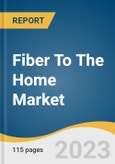The global fiber to the home market is anticipated to reach USD 110.44 billion by 2030, growing at a CAGR of 11.6% from 2023 to 2030. The escalating demand for high-speed internet connectivity is a key driver, fueled by the increasing reliance on data-intensive applications like streaming and remote work. This demand is compelling network providers to expand Fiber To The Home (FTTH) infrastructure to meet consumers' expectations for seamless, fast, and reliable connections. In addition, the integration of smart home technologies and the Internet of Things (IoT) is amplifying the need for robust and uninterrupted connectivity, positioning FTTH as a lynchpin for interconnected living.
Government initiatives and regulations advocating for widespread broadband availability are hastening FTTH deployment, particularly in underserved regions. The strategic synergy between FTTH and emerging technologies like 5G, cloud computing, and AI is further underscoring its significance in modern digital landscapes. As the FTTH market embraces these trends, it continues to redefine how societies engage with technology, enabling transformative experiences and reinforcing its role as an essential pillar of the digital age.
Innovations in optical fiber technology, networking equipment, and data transmission protocols are reshaping the landscape of high-speed internet connectivity. These advancements enable higher data transfer rates, lower latency, and improved reliability, enhancing the overall user experience. Moreover, the development of more efficient installation methods, such as micro trenching and aerial deployments, is streamlining the deployment process and minimizing disruptions to communities.
The COVID-19 pandemic has had a significant impact on the FTTH market. As the pandemic accelerated the shift toward remote work, online education, telehealth, and digital entertainment, the demand for high-speed and reliable internet connections surged. This spotlight on the importance of robust connectivity has underscored the value of FTTH solutions. Telecommunication providers and governments alike have recognized the need to invest in FTTH infrastructure to support the new normal. In addition, the pandemic has emphasized the necessity of bridging the digital divide, urging increased efforts to provide underserved communities with access to fast internet through FTTH networks.
Government initiatives and regulations advocating for widespread broadband availability are hastening FTTH deployment, particularly in underserved regions. The strategic synergy between FTTH and emerging technologies like 5G, cloud computing, and AI is further underscoring its significance in modern digital landscapes. As the FTTH market embraces these trends, it continues to redefine how societies engage with technology, enabling transformative experiences and reinforcing its role as an essential pillar of the digital age.
Innovations in optical fiber technology, networking equipment, and data transmission protocols are reshaping the landscape of high-speed internet connectivity. These advancements enable higher data transfer rates, lower latency, and improved reliability, enhancing the overall user experience. Moreover, the development of more efficient installation methods, such as micro trenching and aerial deployments, is streamlining the deployment process and minimizing disruptions to communities.
The COVID-19 pandemic has had a significant impact on the FTTH market. As the pandemic accelerated the shift toward remote work, online education, telehealth, and digital entertainment, the demand for high-speed and reliable internet connections surged. This spotlight on the importance of robust connectivity has underscored the value of FTTH solutions. Telecommunication providers and governments alike have recognized the need to invest in FTTH infrastructure to support the new normal. In addition, the pandemic has emphasized the necessity of bridging the digital divide, urging increased efforts to provide underserved communities with access to fast internet through FTTH networks.
Fiber To The Home (FTTH) Market Report Highlights
- In terms of product, the more than 1 Gbps segment dominated the market in 2022 with a market share of more than 42.0%. The growing demand for data-intensive applications and emerging technologies is propelling the adoption of ultra-high-speed fiber to the home (FTTH) connections exceeding 1 Gbps
- In terms of service providers, the telecom operators segment dominated the market in 2022 with a revenue share of more than 32.0%, with the expansion of Fiber to the Home (FTTH) networks to meet the surging demand for high-speed internet and capitalize on the convergence of services
- In terms of application, the VoIP segment dominated the market in 2022 with a share of more than 24.0%. The integration of Voice over Internet Protocol (VoIP) services with Fiber to the Home (FTTH) networks is driven by the need for cost-effective and high-quality voice communication in the digital age
- In terms of region, the Asia Pacific region dominated the regional market in 2022 with a revenue share of more than 28.0% owing to the region's expanding economic growth, urbanization, and government initiatives to bridge digital divides
Table of Contents
Chapter 1. Methodology and Scope
Chapter 2. Executive Summary
Chapter 3. Market Variables, Trends, and Scope
Chapter 4. Fiber to the Home (FTTH) Market: Product Estimates & Trend Analysis
Chapter 5. Fiber to the Home (FTTH) Market: Service Provider Estimates & Trend Analysis
Chapter 6. Fiber to the Home (FTTH) Market: Application Estimates & Trend Analysis
Chapter 7. Fiber to the Home (FTTH) Market: Regional Estimates & Trend Analysis
Chapter 8. Competitive Landscape
List of Tables
List of Figures
Companies Mentioned
- AT&T, Inc.
- Ziply Fiber
- Etisalat
- Verizon Communications Inc
- Optimum
- Singtel
- Softbank Group Corp.
- Century Link
- Frontier Communications Parent, Inc.
- Windstream Intellectual Property Services, LLC.
Methodology

LOADING...
Table Information
| Report Attribute | Details |
|---|---|
| No. of Pages | 115 |
| Published | September 2023 |
| Forecast Period | 2022 - 2030 |
| Estimated Market Value ( USD | $ 47.04 Billion |
| Forecasted Market Value ( USD | $ 110.44 Billion |
| Compound Annual Growth Rate | 11.6% |
| Regions Covered | Global |
| No. of Companies Mentioned | 10 |









